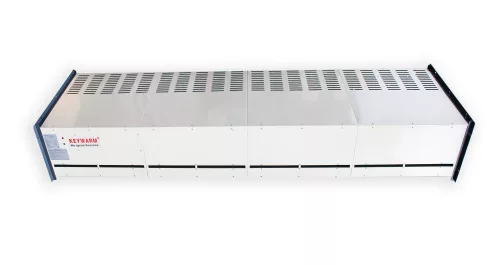APPLICATIONS
- Factories and manufacturing
- Distribution centers
- Warehouses
- Repair shops
- Supermarkets.
- Industrial ovens
ADVANTAGES
- R reduces heating and cooling costs by up to 80% while protecting the internal climate and improving comfort;
Keeps the air clean from pests and insects, dust, air pollution, odors and bad smells, and prevents drafts and the entry of hot and cold air.
No more frequent door openings, increasing production and transportation efficiency.
Improves safety, no solid objects blocking the door.
HOW IT WORKS
Direct fired air curtains work on the same principle as direct fired space heaters. A directionally controlled, high-velocity air stream moves across the height and width of the opening, thereby reducing the infiltration or transfer of air from one side of the opening to the other and/or preventing the passage of flying insects, dust or debris.


High Performance Gas Air Curtains – Efficient Industrial Heating Solutions
Designed for industrial and commercial applications, our gas fired heaters air curtains ensure superior energy efficiency, temperature control, and environmental protection. Designed for warehouses, factories, retail stores, and distribution centers, it creates a strong air barrier to minimize heat loss and increase indoor comfort.
As trusted industrial unit heaters experts, we also offer natural gas unit heaters, gas infrared tube heaters, and Schwank infrared heater replacements to meet a variety of industrial heating needs. Our solutions are designed for maximum energy efficiency, durability, and seamless operation in extreme conditions.
Are you looking for high-quality gas infrared heaters that can be ordered in bulk and shipped worldwide?
Contact us now for a custom quote!
- 35kW-1.5m/50kW-2.25m/70kW-3m/100kW-4.5m
- Powerful centrifugal blower provides high-speed airflow
- Semi-enclosed or fully enclosed equipment available
- Horizontal or side mounting configurations available
- nterlockable with door opening and closing
The following factors should be kept in mind when selecting an air curtain:
Mounting height measured from exhaust diffuser to floor
Door width
The location of the building determines the level of protection required against weather conditions (temperature, humidity, and wind)
If the building has multiple doors in the same area, different or opposite facades
If the building has multiple floors, connected by escalators/stairs
Pressure difference between inside and outside of a building
Door compatibility: always open, automatic open, manual open, revolving door, etc.
Characteristics of ventilation and air conditioning equipment
Voltage and power availability
Type of business, style of venue, and decoration
Free hanging or recessed, horizontal or vertical mounting, heated or unheated, etc.
These factors are essential when selecting or configuring a direct fired air heater or gas fired space heater system to ensure optimal performance, energy savings, and compatibility with other gas unit heaters or climate control infrastructure.
The information in this section is intended for non-technical
Stakeholders provide a “quick check” to confirm their air curtains are properly and functionally
way to install. These inspections are not comprehensive and should not replace the manufacturer’s installation
illustrate.
What is the horizontal distance between the air curtain and the door?
Air curtains should be installed close enough to the opening to prevent heat loss by cool air entering the space and vice versa (applicable to cold rooms). As shown in the figure below, in an ideal installation, there is no horizontal separation between the opening and the air curtain. However, air curtains are still effective as long as the separation distance is within 50 cm.

What is the vertical distance between the air curtain and the door?
Ideally, the outlet of an air curtain should be mounted directly over the opening it is to protect.
If the air curtain is installed too far above the opening, the following two situations may occur:
One result: The air curtains may not be fully effective, or they may need larger and more powerful units. Both of these results in creating and maintaining airflow through the opening.
The result is the energy required. As a general check, a vertical separation of up to 50cm is acceptable unless additional height has been taken into account

Do the air curtains cover the entire width of the door opening?
In a proper installation, the air curtain produces an airflow that covers
The entire opening to be protected during installation. If the air curtain is oversized, it will consume extra energy.
It does not bring any additional benefits to consumers. If the air curtain is too small, it will not
Generates enough airflow to fully protect the opening above the installation, resulting in
Infiltration results in increased costs for heating or cooling the space.


